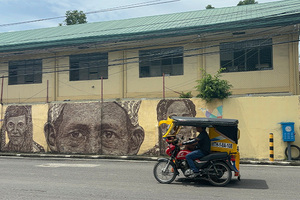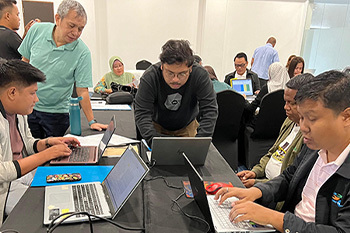
For many, the summer months are a time for rest and vacation travel, and for others, the summer remains work-focused like any other time in the year. At the Kroc Institute for International Peace Studies, part of the Keough School of Global Affairs at the University of Notre Dame, summer can be a bit of both: travel for work.
In July, a handful of Kroc Institute researchers made the long trek from South Bend, Ind., to the Philippines as part of a newly launched global peacebuilding project, the Peace Accords Matrix-Mindanao (PAM-M). The initiative is a partnership between the Kroc Institute and its Peace Accords Matrix (PAM) program and Catholic Relief Services (CRS) – Philippines, in support of the longtime peace process underway in the Philippines.
The PAM-M partners met in Davao City, where they led a week-long workshop with stakeholders from nearly a dozen civil society organizations engaged in peacebuilding in Mindanao. The workshop marked the fifth such gathering to garner feedback on the portion of the peace agreement to which PAM-M is assigned, called the Normalization Annex. This annex, or normalization track, focuses on reintegrating ex-combatants to civilian life and socio-economic reconstruction needed for conflict-affected communities as part of the Comprehensive Agreement on the Bangsamoro that the Government of the Philippines and the Moro Islamic Liberation Front signed in March 2014.

“From the inception of PAM-M, the work of civil society organizations has been front and center,” said Madhav Joshi, a research professor and PAM’s associate director, who serves as the Kroc Institute’s lead for PAM-M.
“The engagement of civil society actors helps advance the implementation process and contributes to post-war peace. They have an indispensable role to play, as they bring the implementation process closer to the communities on the ground, and hold peace process actors accountable, toward shared vision and prosperity.”
For its work on the Normalization Annex, the PAM-M team provides monitoring methodology and technical assistance to measure progress. At the July workshop, PAM-M gathered input from civil society participants on the status of normalization and progress made, and devised a framework for data collection as part of future monitoring work that these organizations will carry out.
Kaye Stacey Sison, area program coordinator at Nonviolent Peaceforce, participated in the workshop and touted the value of facilitating a structured, focused platform for civil society engagement.
“Our organizations are working ‘round the clock to bring sustainable peace to the region,” she said. “PAM-M is breaking new ground with these workshops, as a variety of perspectives surface in our discussions.”
She also noted the importance of PAM-M’s data and measurement in this work. “Data is extremely useful with monitoring and evaluation efforts, resource mobilization and partnerships.”
Ian Digal, the deputy program manager at CRS Philippines, explained how contributions from civil society are one of the main strengths of the PAM-M initiative and what sets it apart from work being done in the political track of the Comprehensive Agreement on the Bangsamoro.

“PAM-M offers a reality check. It highlights the reality on the ground, in the communities and areas covered by the normalization process,” he said.
“It’s the first time for us to encounter such a systematic and structured monitoring and evaluation framework,” added Glen Larot, a project officer with the BALAY Rehabilitation Center, Inc. and another workshop participant.
“There are great hopes among civil society organizations that the work of PAM-M will feed into the national discourse regarding the peace process implementation, influencing the roadmap ahead as the transition period comes to a close.”